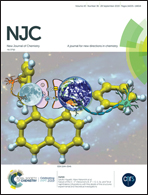Hydrogen elimination reactivity of ruthenium pincer hydride complexes: a DFT study†
Abstract
The tridentate rigid coordination of a pincer ligand in meridional configuration is expected to enhance the catalytic reactivity of a pincer transition metal complex compared to a non-pincer complex composed of a similar ligand environment. Here a DFT study is conducted on a Ru(II) PNN type Milstein catalyst and a large variety of trans-hydrido carbonyl Ru(II) pincer complexes having XZY-type pincer ligands (‘pincer atoms’ X and Y are selected from N, O, S, and P and Z is either C or N) to quantify the reactivity of the water splitting hydrogen elimination reaction. A homodesmotic reaction scheme in conjunction with molecular electrostatic potential (MESP) analysis is used to quantify and characterize the stabilizing/destabilizing effect of the pincer coordination in comparison with non-pincer coordination. The pincer type coordination always led to a more electron-rich ruthenium centre than the non-pincer coordination. The H2 elimination mechanism revealed for the Ru(II) complexes showed a decreasing activation energy (ΔE#) trend with an increase in the electron rich character of the metal centre which is quantified in terms of the MESP at Ru(II), VRu. Pincer complexes having pincer atom Z![[double bond, length as m-dash]](https://www.rsc.org/images/entities/char_e001.gif) N showed a ΔE# of 17.5–21.1 kcal mol−1 (NNN is an exception) for the rate determining H2 elimination step while those having Z
N showed a ΔE# of 17.5–21.1 kcal mol−1 (NNN is an exception) for the rate determining H2 elimination step while those having Z![[double bond, length as m-dash]](https://www.rsc.org/images/entities/char_e001.gif) C showed a ΔE# of 6.9–13.0 kcal mol−1. These results suggest that benzene based XCY type pincer ligands can be more effective than pyridine based XNY type ligands for designing water splitting catalysts.
C showed a ΔE# of 6.9–13.0 kcal mol−1. These results suggest that benzene based XCY type pincer ligands can be more effective than pyridine based XNY type ligands for designing water splitting catalysts.



 Please wait while we load your content...
Please wait while we load your content...